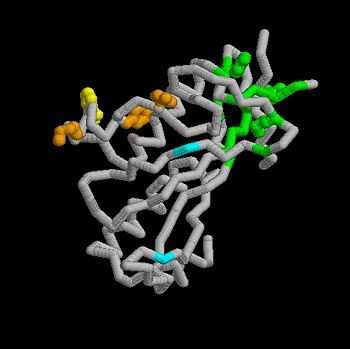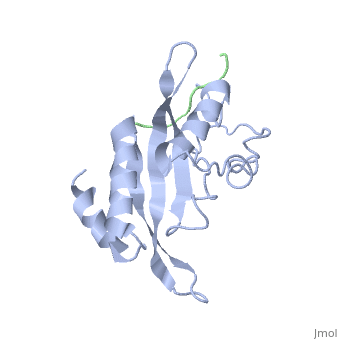User:Lois A. Fridmann/Sandbox 3
From Proteopedia
HIV-1 Gag Recruitment of Tsg101 and the Viral Budding Process
Contents |
Background and History
The Human Immunodefiency Virus (HIV) is the causative agent of acquired immunodefiency syndrome (AIDS) in which the immune system of a human begins to fail, leading to life threatening infections. HIV is a retrovirus that uses its host’s cellular machinery to replicate. The Tumor susceptibility gene 101 [Tsg101], is a human gene that encodes for a cellular protein, plays an important role in the pathogenesis of HIV and belongs to the ubiquitin-conjugating enzyme family, the ubiquitin E2 variant (UEV) subfamily.
In normal functioning cells, Tsg101, as a subunit of the ESCRT-1 (Endosomal Sorting Complex Required for Transport), promotes membrane alterations inside the cell that result in the formation of compartments (multivesicular bodies) in which proteins that have been marked for transport to the lysosome, through ubiquination, are sorted. Normally, a specific tetrapeptide PSAP binding motif on the endosomal protein Hrs (hepatocyte growth factor-regulated tyrosine kinase substrate) will bind to the specific P(S/T)AP binding pocket on the Tsg101 and deliver the protein cargo to endosomes that eventually become or fuse with lysosomes. If HIV is present in a cell, a major structural protein of the virus, Gag, recruits the Tsg101 protein using its own PTAP motif, which mimics the Hrs and binds to the binding pocket of the Tsg101 to gain access to the downstream machinery and to mediate viral budding as an alternative to degradation. The Gag protein is a Group-specific antigen and contains the genetic material that codes for core structural proteins of retroviruses. PTAP and PSAP motifs are able to bind Tsg101 equally.
Poly-ubiquitination inactivates Tsg101, possibly by altering the shuttling of a active membrane-bound protein with an inactive soluble protein.
| |||||||||
| 1m4p, 20 NMR models () | |||||||||
|---|---|---|---|---|---|---|---|---|---|
| Gene: | tumor susceptibility gene 101 (Homo sapiens), Gag (Human immunodeficiency virus 1) | ||||||||
| Related: | 1kpp, 1kpq, 1m4q | ||||||||
| |||||||||
| |||||||||
| Resources: | FirstGlance, OCA, PDBsum, RCSB | ||||||||
| Coordinates: | save as pdb, mmCIF, xml | ||||||||
Structural and Functional Properties of the Tsg101
The features the wild type version of the , amino acid residues Met 1 through Pro 145 and the protein, amino acid residues Pro 1 through Glu 9. Focusing on the Tsg101 UEV domain of this PDB, important features of this protein are observed that may be directly involved in the trafficking or viral budding processes. The Tsg101 is referred to as a UEV domain due to it’s overall α/β/α/ loop configuration that is similar to other E2 ubiquitin ligases, but it does not have the C-terminal helices found in many other E2 enzymes. The Tsg101 C-terminal end is referred to as the C-terminal end of the UEV domain because the precise C-terminal end of the Tsg101 protein has not been determined at this time.
The Tsg101 UEV domain features the PTAP binding pocket represented by amino acid residues: Thr 58; Val 61; Tyr 63; Tyr 68; Asn 69; Ile 70; Pro 71; Thr 92; Met 95; Pro 139; Val 141; Phe 142; Ser 143 and Arg 144. This binding pocket, which normally binds the protein Hrs but can also bind the HIV-1 Gag protein equally.
Another important feature on the Tsg101 that may be involved in the normal trafficking or viral budding process is the ubiquitin-binding pocket. The ubiquitin-binding pocket of the Tsg101 UEV domain has eight specific residues that are involved: residues 43 through 49, and residue 88. The flanking or end domains are Valine 43 and Phenylalanine 88. These residues are highlighted because they mark the ends of the ubiquitin-binding pocket, where ubiquitin binds to help escort the HIV-1 Gag into the trafficking lane and onto the membrane for budding. When the Gag is bound to the PTAP the ubiquitin-binding pocket does not appear to bind more than one ubiquitin. If more than four are bound the Tsg101 is then marked for degradation.
A third structural feature of the Tsg101 UEV domain that may be indirectly involved in the overall trafficking and viral budding is amino acid residues occupying the C-terminal end of the UEV domain. Mutations in this area are discussed below.
Mutations - PTAP binding pocket, ubiquitin binding pocket, C-terminal UEV Domain
The specific HIV Tsg101 Ubiquitin E2 Variant (UEV) domain model represents the wild type version of the Tsg101 UEV domain with specific highlights of the PTAP binding site featured as a green backbone and three residues in the PTAP binding site (, , ), which are also colored green.. Four C-terminal domain residues , , colored orange and colored yellow, and two residues included in the Ubiquitin binding site featured as a cyan colored backbone (, ).
Future Research and Therapies
References
1. Liu F, Stephen Ag, Adamson C, Gousset K, Aman MJ, Freed EO, Fisher RJ, Burke TR, Jr. 2005. Hydrazone and Hydrazide-Containing N-Substituted Glycines as Peptoid Surrogates for Expedited Library Synthesis: Application to the Preparation of Tsg101-Directed HIV-1 Budding Antagonist. Org Lett 8: 5163-5168.
2. Macias M, Wiesnera S, Sudolb M. 2002. WW and SH3 domains, two different scaffolds to recognize proline-rich ligands. Protein Domains 513:30-37.
3. Pornillos O, Alam S, Davis D, Sundquist W. 2002. Structure of the Tsg101 UEV domain in complex with the PTAP motif of the HIV-1 p6 protein. Nature Structural Biology 9:812 – 817.
4. Pornillos O, Higginson D, Stray K, Fisher R, Garrus J, Payne M, He G, Wang H, Morham S, Sundquist W. 2003. HIV Gag mimics the Tsg101-recruiting activity of the human Hrs protein. The Journal of Cell Biology 162: 425-434.
5. Tavassoli A, Lu Q, Gam J, Pan H, Benkovic S, Cohen S. 2008. Inhibition of HIV Budding by a Genetically Selected Cyclic Peptide Targeting the Gag-TSG101 Interaction. American Chemical Society, Chemical Biology 3:757 - 764.
6. VerPlank L, Bouamr F, LaGrassa T, Agresta B, Kikonyogo A, Leis J, Carter C. 2001. Tsg101, a homolgue of ubiquitin-conjugating (E2) enzymes, binds the L domain of HIV type 1 Pr55Gag. Proceeding of the National Academy of Science 98:7724 – 7729.



